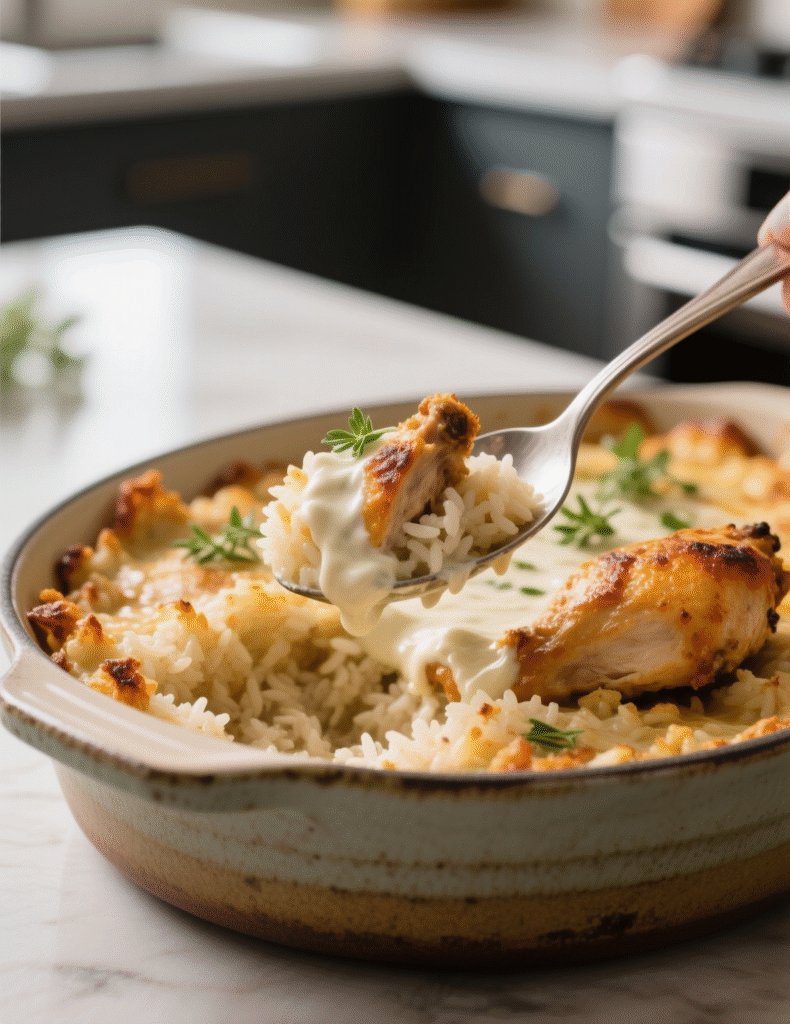There’s a certain kind of joy in a dish that practically cooks itself. The Dump and Bake Chicken Tzatziki Rice recipe is one of those dishes. You throw everything together in one dish, tuck it into the oven, and let the alchemy of heat and time do the hard work. It feels like cheating, except the result is as layered and nuanced as something that took hours of fiddling on the stove. For chefs, home cooks, or professionals designing efficient menus, this recipe walks that rare line between ease and depth.
The Core Idea Behind Dump and Bake
Dump and bake cooking isn’t new. Casseroles, gratins, and pilafs have been doing the same job for centuries. The difference lies in how modern cooks crave efficiency without losing integrity of flavor. Professional kitchens may turn their noses up at the phrase, but truth is, the method saves time, reduces waste, and ensures consistent results.
Think of it this way: every kitchen has bottlenecks. Fryers backed up, sauté pans overfilled, and too many eyes on a single sauce. A dump-and-bake dish like chicken tzatziki rice doesn’t just feed—it frees up labor. You prep once, load trays, and forget until service.
Why Tzatziki and Rice?
Tzatziki isn’t the first sauce you’d imagine baking into rice, yet it works surprisingly well. The yogurt base tenderizes chicken as it bakes, creating a mild acidity that keeps proteins moist. The cucumbers, though delicate raw, cook down into subtle background notes of freshness rather than vanishing. Garlic and dill don’t just hang around—they perfume the entire tray.
Rice absorbs flavor like a sponge in the sun. It picks up the yogurt tang, the olive oil richness, and the lemon sharpness. What you end up with isn’t just rice, but rice that has lived a story with the chicken.
Building the Dish
At its most basic, the recipe requires rice, chicken, tzatziki, stock, and a few Mediterranean extras. But anyone who’s worked in professional kitchens knows—basic rarely means enough. The quality of each component decides if the dish sings or mumbles.
Choosing the Rice
Long-grain white rice, basmati, or jasmine all work. Each absorbs liquid differently, so ratios matter. For instance, jasmine will swell softer, giving a slightly stickier base. Basmati holds a more individual grain, almost pilaf-like. In professional service, basmati is often the safer choice—less clumping when reheated.
Parboiled rice isn’t recommended here. It resists absorption, leaving you with yogurt sauce floating on top rather than woven into grains.
Selecting the Chicken
Boneless, skinless chicken thighs are the gold standard. Their higher fat content handles longer baking times without drying. Breast meat can be used, but it risks turning stringy if baked too long. If you must use breast, consider cutting it into larger chunks to slow the drying process.
Bone-in thighs, oddly enough, change the game. They take longer to cook, but their rendered fat adds a richness to the rice. It’s a tradeoff between efficiency and depth.

The Tzatziki Component
Traditional tzatziki is yogurt, cucumber, garlic, lemon, dill, and olive oil. For baking, you want it slightly thicker than dipping consistency. Straining yogurt for at least 2 hours before mixing helps. Cucumbers should be seeded and salted in advance to reduce water release in the oven.
Commercial tzatziki sauces tend to be thinner, often with stabilizers. In large-scale cooking, this can actually help, because they maintain texture through baking. But in small-batch or artisan cooking, homemade remains unmatched.
The Science of Bake Integration
When baked, yogurt undergoes gentle caramelization around edges. It doesn’t curdle if fat and starch balance is correct. The rice starch interacts with yogurt proteins, keeping them from splitting. Think of it as a built-in sauce stabilizer.
Chicken proteins denature around 150°F, tenderizing in the acidic yogurt bath. The dill’s volatile oils hold up better under covered baking than in open pan sautéing. Garlic, meanwhile, mellows and sweetens, losing its harsh bite.
Every element shifts slightly from its raw form, yet they unify under oven heat into something cohesive.
Step-by-Step Methodology
1. Prepare the Base
Lightly oil a baking dish. Spread uncooked rice evenly, almost like laying foundation stones. Scatter garlic and onion for depth.
2. Liquid Ratio Control
For every cup of rice, aim for 1 ¾ cups liquid when using yogurt as part of the mixture. Too little, and rice bakes uneven. Too much, and you drown flavor. A stock-yogurt-lemon blend is ideal.
3. Chicken Placement
Place chicken directly atop the rice mixture. This allows juices to drip down, flavoring grains beneath. Don’t overcrowd, or steam forms pockets instead of roasting flavors.
4. Seal and Bake
Cover tightly with foil. Bake at 375°F for 40–45 minutes for boneless thighs. Rest covered for 10 minutes before uncovering. Rice finishes absorbing during this stage.
5. Finishing Touches
Stir in a fresh spoonful of tzatziki before serving. This creates contrast between baked, mellowed flavors and the bright, raw freshness of yogurt-cucumber.
Professional Adaptations
Restaurants rarely stick to the home version. A few real-world variations:
- Bulk Catering: Pre-bake rice separately, then layer with baked chicken and tzatziki for faster plating.
- Health-Conscious Menus: Substitute brown rice, though it requires par-cooking before baking.
- Fine Dining Twist: Use preserved lemon and roasted garlic in tzatziki for deeper flavor complexity.
- Meal Prep Services: Portion into reheatable containers. Basmati ensures grains stay separate after microwaving.

Flavor Pairings
This dish doesn’t sit alone on the plate. Think of sides as flavor echoes. Roasted peppers and eggplant complement its earthiness. A sharp Greek salad contrasts with its creaminess. Even simple pita bread works, soaking up sauces that cling to the edge of the pan.
For wines, crisp whites like Assyrtiko or Sauvignon Blanc cut the yogurt’s richness. For beer menus, a light pilsner or saison works well.
Misconceptions and Mistakes
One common mistake: assuming tzatziki will burn or split in the oven. Proper ratios prevent that. Another misconception is that cucumbers disintegrate. In reality, they soften but still lend subtlety.
Some chefs overcomplicate the dish with too many spices. Remember—Mediterranean flavors sing louder when restrained. A little dill, a touch of lemon, and garlic that whispers instead of shouts. That’s enough.
Emerging Trends in One-Pan Mediterranean Cooking
Global data shows rising demand for Mediterranean-inspired meal kits. According to Euromonitor, the Mediterranean ready-meals category has grown 12% annually in the US since 2019. This reflects a consumer push toward “healthy convenience.”
Dump-and-bake chicken tzatziki rice sits perfectly in that niche. It’s familiar enough for Western palates but still exotic enough to feel new. Professional kitchens looking to adapt menus for delivery should take note.
Answering the “But Why Bake?” Question
Some might ask—why not just cook rice, grill chicken, and serve with tzatziki on the side? You can, and it’ll be fine. But baking integrates flavor differently. Rice infused with chicken juices and yogurt is not the same as plain rice with sauce poured on top. It’s the difference between acquaintance and marriage.
Nutritional Analysis
Per serving (based on chicken thigh and basmati rice):
- Calories: 520
- Protein: 36g
- Carbohydrates: 48g
- Fat: 19g
- Fiber: 2g
This balance hits modern demands: high protein, moderate carbs, healthy fats from olive oil and yogurt. It’s not diet food, but it is nutrient-dense fuel.
Final Thoughts
Dump and Bake Chicken Tzatziki Rice isn’t just a recipe—it’s a framework. It shows how flavors can merge with little intervention. For professionals, it’s a tool for labor efficiency, consistency, and scalable flavor. For home cooks, it’s a comforting tray of food that feels like far more work than it is.
The key is respecting each ingredient, treating the yogurt not as a garnish but as a partner to rice and chicken. Once baked, the dish loses its individual identities and becomes something greater—something that lingers in memory longer than the prep time ever suggested it would.
FAQs
What type of rice works best for Dump and Bake Chicken Tzatziki Rice?
Basmati rice is best because it stays fluffy and absorbs flavor evenly.
Can I use chicken breast instead of thighs?
Yes, but thighs stay juicier while breasts can dry out if baked too long.
Will the tzatziki sauce curdle in the oven?
No, if ratios are correct the yogurt binds with rice starch and stays creamy.
Should I make homemade tzatziki or use store-bought?
Homemade gives fresher flavor, but thicker store-bought versions hold up better for bulk cooking.
Can I substitute brown rice in this recipe?
Yes, but brown rice needs partial cooking first since it takes longer to soften.
What’s the ideal liquid-to-rice ratio for baking?
About 1 ¾ cups liquid for every 1 cup of rice works best with yogurt included.
Do cucumbers in tzatziki disappear during baking?
No, they soften and melt into the dish, leaving a subtle freshness.
How long should I bake chicken with rice?
Usually 40–45 minutes at 375°F for boneless thighs, covered with foil.
What sides go well with this dish?
Greek salad, roasted vegetables, or warm pita bread pair beautifully.
Can I meal prep this recipe ahead of time?
Yes, it reheats well and basmati rice keeps grains from clumping.

Mariana is a passionate home cook who creates delicious, easy-to-follow recipes for busy people. From energizing breakfasts to satisfying dinners and indulgent desserts, her dishes are designed to fuel both your body and hustle.
When she’s not in the kitchen, she’s exploring new flavors and dreaming up her next recipe to share with the Foodie Hustle community.

